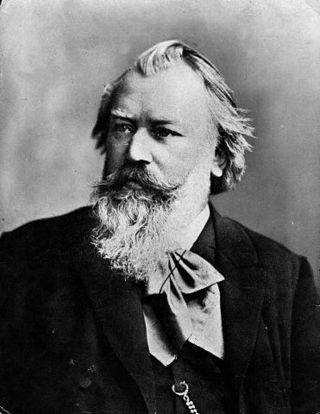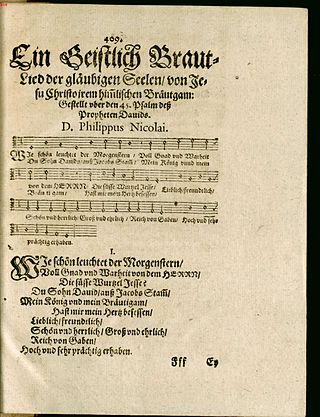Related Research Articles

Johannes Brahms was a German composer, pianist, and conductor of the mid-Romantic period. Born in Hamburg into a Lutheran family, he spent much of his professional life in Vienna. He is sometimes grouped with Johann Sebastian Bach and Ludwig van Beethoven as one of the "Three Bs" of music, a comment originally made by the nineteenth-century conductor Hans von Bülow.

Charles Edward Ives was an American modernist composer, one of the first American composers of international renown. His music was largely ignored during his early career, and many of his works went unperformed for many years. Later in life, the quality of his music was publicly recognized through the efforts of contemporaries like Henry Cowell and Lou Harrison, and he came to be regarded as an "American original". He was also among the first composers to engage in a systematic program of experimental music, with musical techniques including polytonality, polyrhythm, tone clusters, aleatory elements, and quarter tones. His experimentation foreshadowed many musical innovations that were later more widely adopted during the 20th century. Hence, he is often regarded as the leading American composer of art music of the 20th century.

Chamber music is a form of classical music that is composed for a small group of instruments—traditionally a group that could fit in a palace chamber or a large room. Most broadly, it includes any art music that is performed by a small number of performers, with one performer to a part. However, by convention, it usually does not include solo instrument performances.
The Universe Symphony is an unfinished work by American classical music composer Charles Ives.
Cyclic form is a technique of musical construction, involving multiple sections or movements, in which a theme, melody, or thematic material occurs in more than one movement as a unifying device. Sometimes a theme may occur at the beginning and end ; other times a theme occurs in a different guise in every part.
The Trio for Violin, Cello, and Piano is a work by the American composer Charles Ives. According to his wife, the three movements of the piano trio are a reflection of Ives’ college days at Yale. He started writing the piece in 1904, six years after graduation, and completed it in 1911. It was written c.1909–10 and significantly revised in 1914–15.

The Grosse Fuge, Op. 133, is a single-movement composition for string quartet by Ludwig van Beethoven. An immense double fugue, it was universally condemned by contemporary music critics. A reviewer writing for the Allgemeine musikalische Zeitung in 1826 described the fugue as "incomprehensible, like Chinese" and "a confusion of Babel". However, critical opinion of the work has risen steadily since the early 20th century and it is now considered among Beethoven's greatest achievements. Igor Stravinsky described it as "an absolutely contemporary piece of music that will be contemporary forever".

The Three Places in New England is a composition for orchestra in three movements by American composer Charles Ives. It was written mainly between 1911 and 1914, but with sketches dating as far back as 1903 and last revisions made in 1929. The work is celebrated for its use of musical quotation and paraphrasing.

Christ lag in Todes Banden, BWV 4, is a cantata for Easter by German composer Johann Sebastian Bach, one of his earliest church cantatas. It is agreed to be an early work partly for stylistic reasons and partly because there is evidence that it was probably written for a performance in 1707. Bach went on to complete many other works in the same genre, contributing complete cantata cycles for all occasions of the liturgical year. John Eliot Gardiner described it as Bach's "first-known attempt at painting narrative in music".

Jesu, meine Freude, BWV 227, is a motet by Johann Sebastian Bach. The longest and most musically complex of Bach's motets, it is set in eleven movements for up to five voices. It is named after the Lutheran hymn "Jesu, meine Freude" with words by Johann Franck, first published in 1653. The motet contains the six stanzas of the hymn in its odd-numbered movements. The hymn tune by Johann Crüger appears in all of these movements in different styles of chorale settings. The text of the motet's even-numbered movements is taken from the eighth chapter of the Epistle to the Romans, a passage that influenced key Lutheran teachings. The hymn, written in the first person with a focus on an emotional bond with Jesus, forms a contrasting expansion of the doctrinal biblical text. Bach set both texts alternating with and complementing each other, in a structure of symmetries on different layers.

Charles Ives's Symphony No. 4, S. 4 was written between 1910 and the mid-1920s. The symphony is notable for its multilayered complexity—typically requiring two conductors in performance—and for its large and varied orchestration. Combining elements and techniques of Ives's previous compositional work, this has been called "one of his most definitive works"; Ives' biographer, Jan Swafford, has called it "Ives's climactic masterpiece".

A Symphony: New England Holidays, also known as A New England Holiday Symphony or simply a Holiday Symphony, is a composition for orchestra written by Charles Ives. It took Ives from 1897 to 1913 to complete all four movements. The four movements in order are:

"Wie schön leuchtet der Morgenstern" is a Lutheran hymn by Philipp Nicolai written in 1597 and first published in 1599. It inspired musical settings through centuries, notably Bach's chorale cantata Wie schön leuchtet der Morgenstern, BWV 1, but also vocal and instrumental works by Baroque composers, Peter Cornelius, Felix Mendelssohn, Max Reger, Hugo Distler, Ernst Pepping, Mauricio Kagel and Naji Hakim.

John Kirkpatrick was an American classical pianist and music scholar, best known for championing the works of Charles Ives, Aaron Copland, Carl Ruggles, and Roy Harris. He gave the first complete public performance of Ives's Concord Sonata in 1939, which became a turning point in the composer's public recognition. Kirkpatrick played an important role in Ives scholarship, and he was leader in the Charles Ives Society. One important example is his role in the editing of Memos, which is a collection of Ives's autobiographical writings. At the time of his death Kirkpatrick was a professor emeritus at Yale University, where he had also been the curator of the Charles Ives archives.
Orchestral Set No. 2 is the title of a three-movement work by the American composer Charles Ives. A typical performance lasts around seventeen minutes.

The Connecticut March is a song originally from 1911, written by William Nassann. It was republished in 1913 and published again by Paull-Pioneer Music in 1938.
J. Peter Burkholder is an American musicologist and author. He is Distinguished Professor Emeritus of Musicology at the Indiana University Jacobs School of Music. He has written numerous monographs, essays, and journal articles on twentieth-century music, Charles Ives, musical borrowing, American music, musical meaning, analysis, and music history pedagogy. He is the principal author of A History of Western Music, 10th Edition, published by W. W. Norton & Company.

Chorale is the name of several related musical forms originating in the music genre of the Lutheran chorale:
The String Quartet No. 2 by Charles Ives is a work for string quartet written between 1907 and 1913. It was premiered at McMillin Theatre, Columbia University in New York City on May 11, 1946, by a Juilliard School student ensemble. Its first professional performance was by the Walden String Quartet, on September 15, 1946, at Yaddo, on a concert which prompted composer Lou Harrison to write: "This work is... the finest piece of American chamber music yet... Music of this kind happens only every fifty years or a century, so rich in faith and so full of the sense of completion." In his Memos, Ives referred to the quartet as "one of the best things I have".
References
- 1 2 3 4 Morgan, Robert P. (1975). Charles Ives: String Quartets Nos. 1 & 2 (liner notes). The Concord String Quartet. Nonesuch Records. H-71306.
- ↑ Sinclair, James B. (1999). A Descriptive Catalogue of the Music of Charles Ives. Yale University Press. p. 166. hdl:10079/fa/music.mss.0014.1.
- ↑ Swafford, Jan (1996). Charles Ives: A Life with Music. W. W. Norton. pp. 124–125.
- ↑ Swafford, Jan (1996). Charles Ives: A Life with Music. W. W. Norton. p. 125.
- 1 2 Ives, Charles E. (1972). Kirkpatrick, John (ed.). Memos. W. W. Norton. pp. 154–155.
- ↑ Perlis, Vivian (1974). Charles Ives Remembered: An Oral History. Norton. p. 158.
- ↑ Swafford, Jan (1996). Charles Ives: A Life with Music. W. W. Norton. p. 451.
- ↑ Sinclair, James B. (1999). A Descriptive Catalogue of the Music of Charles Ives. Yale University Press. p. 168. hdl:10079/fa/music.mss.0014.1.
- ↑ Ives, Charles E. (1972). Kirkpatrick, John (ed.). Memos. W. W. Norton. p. 155.
- ↑ Swafford, Jan (1996). Charles Ives: A Life with Music. W. W. Norton. p. 126.
- 1 2 3 Burkholder, J. Peter (1995). All Made of Tunes: Charles Ives and the Uses of Musical Borrowing. Yale University Press. p. 70.
- 1 2 Burkholder, J. Peter (1995). All Made of Tunes: Charles Ives and the Uses of Musical Borrowing. Yale University Press. p. 71.
- ↑ Burkholder, J. Peter (1995). All Made of Tunes: Charles Ives and the Uses of Musical Borrowing. Yale University Press. p. 72.
- ↑ Burkholder, J. Peter (1995). All Made of Tunes: Charles Ives and the Uses of Musical Borrowing. Yale University Press. p. 52.
- ↑ Burkholder, J. Peter (1995). All Made of Tunes: Charles Ives and the Uses of Musical Borrowing. Yale University Press. p. 54.
- ↑ Burkholder, J. Peter (1995). All Made of Tunes: Charles Ives and the Uses of Musical Borrowing. Yale University Press. pp. 54–55.
- 1 2 Burkholder, J. Peter (1995). All Made of Tunes: Charles Ives and the Uses of Musical Borrowing. Yale University Press. pp. 58–59.
- ↑ Burkholder, J. Peter (1995). All Made of Tunes: Charles Ives and the Uses of Musical Borrowing. Yale University Press. pp. 57–62.
- ↑ Burkholder, J. Peter (1995). All Made of Tunes: Charles Ives and the Uses of Musical Borrowing. Yale University Press. p. 50.
- ↑ Ives, Charles E. (1972). Kirkpatrick, John (ed.). Memos. W. W. Norton. p. 54.
- ↑ Burkholder, J. Peter (1995). All Made of Tunes: Charles Ives and the Uses of Musical Borrowing. Yale University Press. p. 60.
- ↑ Burkholder, J. Peter (1995). All Made of Tunes: Charles Ives and the Uses of Musical Borrowing. Yale University Press. p. 55.
- ↑ Burkholder, J. Peter (1995). All Made of Tunes: Charles Ives and the Uses of Musical Borrowing. Yale University Press. p. 59.